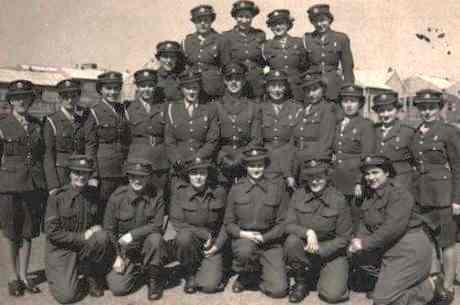
Royal Artillery
(A.T.S. Remembered)
 |
Royal Artillery(A.T.S. Remembered)
|
Not all A.T.S. personnel were part of the Command structure of the A.T.S. Lt General Sir Frederick Pile (Commander in Chief of Anti Aircraft Command) had experimented with the idea of 'manning' Ack Ack batteries with A.T.S. personnel and when, in 1941, there was a shortage of men to defend Britain, he took the opportunity to introduce batteries comprising male and female service personnel. The A.T.S. personnel in these batteries, became attached to Royal Artillery regiments.

The specific part of the Royal Artillery that the A.T.S. were attached to was Air Defence G.B., Anti Aircraft Command, also known as Ack Ack Command. Ack Ack was the name given to the anti-aircraft guns in the same way that the German anti-aircraft defences were called 'flack'.
Anti Aircraft Command was in operation from April 1939 and was responsible for the defence of Great Britain from the Luftwaffe. The R.A. Regiments were divided into Batteries which were termed 'Mixed' when A.T.S. members were attached to them. There were two Batteries to a Regiment and they were located at bases all over the country. There were also special training camps for the personnel of these Batteries and practice camps where they fired at targets and drones. A.T.S. Kinetheodolite operators were often in situ at these practice camps. Their special equipment was able to track the practice rounds and using a combination of film and theodolite technology, they were able to work out how good the teams were at reaching their targets.
When the V1 and V2 rockets were sent over the East coast of the U.K. in 1944, most of the R.A. Ack Ack Batteries were moved to form a dense belt of protection. This area became known as doodle bug alley. The aim was to fire constantly at the rockets in an attempt to knock them out of the sky. Unfortunately for the Batteries, the V1 was usually too fast for them to shoot down, although not as fast as the V2 turned out to be.
Following 'D' Day on 6 June 1944 some mixed batteries were sent after the main deployment of troops, to strengthen the line of defence across Europe as it moved towards the east. However, the success of 'D' Day and the subsequent surrender meant that the batteries quickly dissolved and although many A.T.S. stayed in service, they were moved from Anti Aircraft defence to general clerical work until their demobilisation.
BuzyBee
Web Design  |